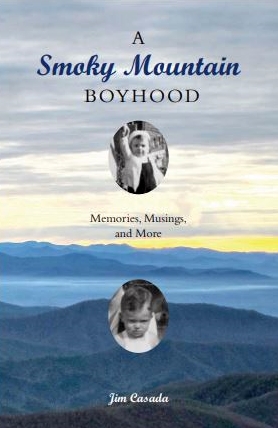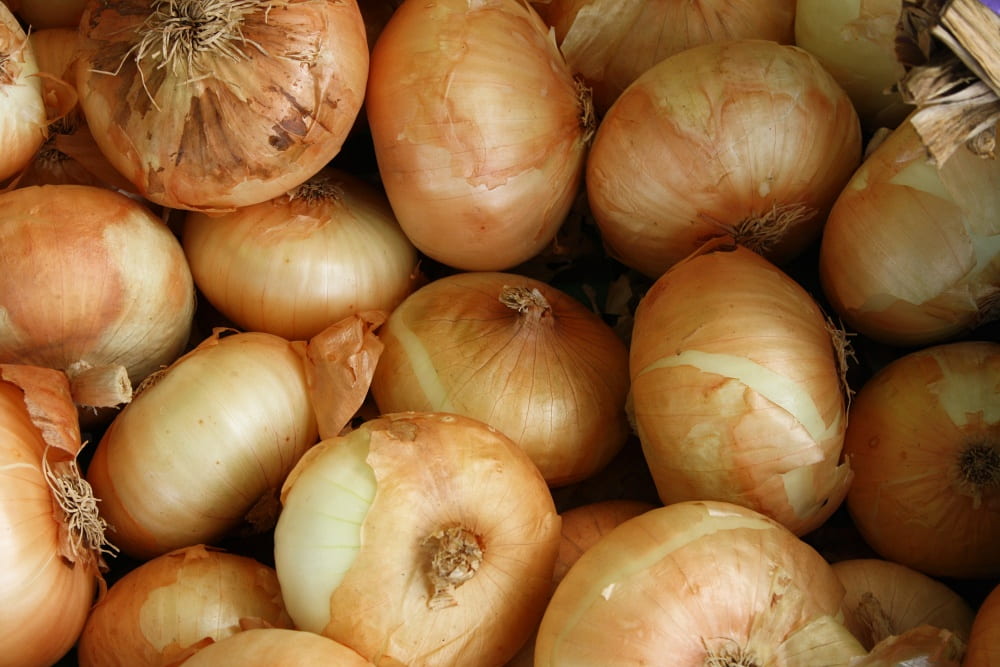THE HEART OF SUMMER: HEAT, HOMECOMINGS,
AND HARKENING BACK TO SIMPLER DAYS
As is all too obvious, since this “July” newsletter will likely reach you in early August, I’m in the throes of a situation Grandpa Joe liked to describe as “the harder I go the behinder I get.” In truth his simple life seldom if ever saw him get much behind on anything. If a patch of corn needed hoeing, it received the necessary attention in prompt order. If crops needed harvesting, and there was plenty of that to be done at this season of the year, it was handled. Similarly, Grandma Minnie would be laboring away in the kitchen, with jar after jar of canned goods appearing and staying in her “office” for a few days to make sure they sealed before going to increasingly full shelves in the cannery.
They both worked with a will and seemed to have an uncanny knack for getting things done yet finding free time for simple pleasures such as sitting on the porch of an evening or when it was too hot to do much manual labor. Grandpa also loved to walk to town for a session at Loafer’s Glory (see more below), while Grandma was fortunate enough to have a dear friend just across the way with whom she could visit. My grandparents’ home didn’t have air conditioning or even fans, but massive maples shaded the house and the nearby river always seemed to caress the nearby land where they lived with gentle breezes. Porch sessions with family or friends, with maybe some stringing and breaking of beans, peeling early apples, cutting up a watermelon, or making a churn of hand-cranked ice cream were treasured. There was no radio, much less a television, but they understood the balance between labor and rest that’s largely missing today.
I’m afraid I’m guilty of imbalance to some degree, but in truth always having something to do—another book project, article assignments to complete, yard and garden chores, and much more—is good for my state of mind. The sanctity of work is also deeply ingrained in my character, as was the case with not only my grandparents but my parents. They labored hard and worked long hours, but they understood relaxation. Speaking of a sound work ethic, I recently told my granddaughter, in a belated get together jointly celebrating her 21st birthday and Father’s Day, that one of the things about her which gave me great pride was her willingness to work. The same holds true for her mother, with both understanding that out of dedication to whatever job is at hand good things ultimately happen.
That’s a rather long-winded excursion down a side trail from trying to explain why this newsletter is late, but at least I can say that I’ve been busy. You’ll be able to learn more in “Jim’s Doings” below, but first I want to devote some space to celebrating a part of my Appalachian heritage that has always intrigued me. As longtime readers know, I’m deeply in love with my roots and have endeavored, in print and in person, to celebrate them in a variety of ways. One thing I particularly cherish is verbal lore and the manner in which folks from my native North Carolina high country employ language to describe life. I’m going to devote most of my space this month to examples capturing the essence of what is frequently described as mountain talk.
SAYINGS AND SIMILES, APHORISMS AND ANALOGIES
As a boy growing up in Bryson City, NC, I spent an inordinate amount of time, especially during the summer, hanging on every word of the old codgers who gathered daily, except Sundays, on the town square. In fact, I was so enamored of what went on there that I devote an entire chapter to the old-timers and their activities such as knife swapping, telling of tales (tall and maybe occasionally true), playing checkers, critiquing local politicians and preachers, in my book A Smoky Mountain Boyhood. The title of the chapter is “The Lords of Loafer’s Glory,” and Loafer’s Glory was one name commonly applied to the place. The other, and it saw more frequent use, at least among males, was “Dead Pecker Corner.” That description is unquestionably crude but it instantly paints an unforgettable image.
That’s what I find so delightful about mountain talk, and I’d like to share a sampling, and it is but the merest tip of a massive iceberg of sayings, of ways I’ve heard everything from weather to religion described by folks in the place of my roots. They are colorful, often earthy, and invariably expressive. They also have come to be, over the course of my life, an integral part of my own manner of speaking. They come out involuntarily, but it’s surprising how often someone will chuckle or ask me how in the world I came up with that. I really don’t have an answer other than to say, in most cases, “it’s something I’ve heard all my life.” Here’s a verbal hors d’oeuvre, so to speak, and I’d love to hear from you in regards to sayings that are familiar to you or that you find particularly descriptive.
WEATHER
*It’s hot as the hinges of the gates to hell.
*It’s hotter than Beelzebub’s backside.
*It rained like pouring piss out of a rubber boot.
*It rained like a milk cow pissing on a flat river rock.
*It’s colder than a whore’s heart.
*It’s colder than a well digger’s ass in Nome, Alaska.
*Hotter than a vixen fox in season caught in a forest fire.
HUMAN CHARACTERISTICS
*She’s so ugly she’d made a Greyhound bus take a dirt road.
*He’s uglier than homemade sin.
*That fellow is a dense as a laurel thicket.
*He’s fuller of tricks than a pet ‘coon.
*She’s so buck-toothed she could eat corn on the cob through a chicken wire fence.
*When the girl he had a crush on agreed to date him, he grinned like a mule eating saw briers.
*Grinning like a ‘possum eating ripe persimmons.
*That girl is sweet as a fine run of sorghum syrup.
*That old boy is so bad to fish he’d purt night skip church and leave his family if they were biting good.
*He’s got pistol grip ears.
*Talk about big—that woman is a full two ax handles wide across the ass.
*He’s as useless as a one-legged man in an ass-kicking contest.
*He’s sorry as an egg-sucking dog.
*He’s so tight he’d squeeze a buffalo nickel until the buffalo hollered for help.
*He’s tighter than Dick’s hat band.
*She’s cute as a speckled pup.
*He’s as over-sexed as a goat in a herd of sheep.
*She was hungry enough to eat liver fried in coal tar.
*She was so embarrassed her face turned as red as a fox’s ass in pokeberry time.
*That woman told a tale so sad it would bring tears to a glass eye (the analogy is also frequently used as a means of expressing pleasure or delight—“a big bowl of her pot likker will bring tears to a glass eye”).
*That girl’s bright as a new penny.
*He’d talk the ears off a Georgia mule.
*He’s got a tongue that wags at both ends.
*She’s got chinquapin eyes.
*She’s pretty as a painted picture.
*He’s sharp as a well-honed knife.
HEALTH
*I’m so as to be out and about.
*I’m able to sit up and take nourishment.
*I’m hanging in there like a hair in a biscuit.
*That meat must have been off. It made me sick as a dog.
*I’m feeling fit as a well-tuned fiddle.
*A nip of that tanglefoot will put pep in your step, but too much will leave you feeling like death warmed over.
OTHERS
*Faster than greased lightning.
*Slicker than a mole’s ass.
*Lower than a snake.
*Sneakier than a snake.
*Meaner than a snake.
*Happy as a hog in the sunshine.
*Worn to a frazzle.
*Fine as snuff and not nearly as dusty.
*That smells so bad it would knock a skunk off a gut wagon.
JIM’S DOIN’S

Most of my activity for the past six weeks or so has focused on work connected with books. Finally, after sundry delays and production setbacks, Fishing for Chickens: A Smokies Food Memoir is available. All of you who graciously pre-ordered should have your copy in hand, and if not, please let me know forthwith. For other readers, I’d be all too happy to sell you a copy ($28.95 + $5.00 shipping), and of course I’ll gladly sign and inscribe copies.

The book is a sort of partner or adjunct to my earlier A Smoky Mountain Boyhood: Memories, Musings, and More. If you don’t have it (and I must have done something right because the work won four different awards), I’ve got plenty of copies ($29.95 + $5.00 shipping). Writing is how I earn my modest living, and books are a centerpiece of that livelihood. A new book is something like a newly arrived child. It brings excitement after long anticipation, anxiety on how the work will be accepted, no small sense of accomplishment, and hopes for a modest uptick in income.
In addition to efforts connected with marketing the book, filling orders, making sure review copies get in the hands of the right media, entering competitions for books, and the like, there has been a second book present in my daily efforts in a big way. This is a cookbook, yet to be given a final title but serving as a celebration of Appalachian foodways through scores of recipes linked to the region, I am co-authoring with the woman who makes this monthly newsletter possible as my webmaster, Tipper Pressley. As those of you who read her daily blog, “Blind Pig & the Acorn,” or watch her YouTube videos, “Celebrating Appalachia,” already know, she’s a culinary wizard closely linked to the highland homeland we both cherish. Incidentally, if you aren’t linked to her blog and YouTube offerings and have a hankering for anything and everything connected with the southern Appalachian way of life, you need to give yourself a treat. For many folks the reading and watching are a daily tonic—and they cost you nothing.
We have made grand progress on the cookbook and, as of this writing, pretty well have the heart of the book completed. It consists of twenty-seven chapters focusing on everything from “preacher bird” (chicken) to jams and jellies, from corn as a staff of mountain life to traditional desserts like stack cake and fried pies. The publisher has graciously agreed to incorporate plenty of illustrative material and we are working on that, along with some of ancillary essentials including the introduction, a glossary of traditional food terminology, and the like. By the time I write the next newsletter I fully expect we will have sent a completed manuscript to the publisher. At that juncture I’ll beginning provide periodic updates on where things stand.
Still on the book front, although it is far from a done deal (I need to see and negotiate on the contract), things look promising for a massive venison cookbook that will combine the two works in that subject area I wrote with my late wife, The Complete Venison Cookbook and The Ultimate Venison Cookbook. If that happens, it will mean a work with well over 400 ways to prepare deer meat.
Beyond that, there’s the usual sprinkling of recently published articles. I write a column every week for the Smoky Mountain Times along with frequent contributions to regionally focused magazines and outdoor-related publications. Here is a list of what’s appeared since the last newsletter: “Eat Taters: They’ll Stick to a Man’s Ribs,” “Smoky Mountain Living” (on line), July 8, 2022; “Wisdom from Old-Time Sayings,” Smoky Mountain Living, Summer, 2022, pp. 95-96; “Home Grown,” Columbia Metropolitan, July/August, 2022, pp. 94-99; “Third Century…Three Hundred Turkeys Later,” Sporting Classics, Early Summer 2022 edition, pp. 66-70; “Meet Mister Brooks,” Sporting Classics, Early summer, 2022, pp. 140-42; “The Delights of Vegetable Mixes,” Smoky Mountain Living, Aug./Sept., 2022, pp. 18-21; and “John Parris: Muse of the Mountains,” Smoky Mountain Living, Aug./Sept., 2022, pp. 60-68.
RECIPES
THE HUMBLE ONION

In an exchange of e-mails with my brother, Don, and Tipper Pressley in connection with the cookbook in progress mentioned above, he had a look at some of the recipes for potatoes in one of the chapters. He offered some insight on supporting photography, which was the focal point of the e-mail exchange, but also pointed asked: “Where your recipe for fried potatoes and onions?” His question was a logical and penetrating one, because that’s a dish that long has been a central feature of meals on backcountry camping trips (especially when paired with trout) and a dish making a regular appearance on tables in mountain homes.
Yet even his question begged another question; namely, why does the humble onion get overlooked with such regularity? After all, it is a fixture in any serious garden, versatile to an incredible degree, a condiment that goes well with a whole bunch of other vegetables along with a pone of cornbread, onions keep well, and much more. Still, somehow, they get relegated to the back row when cooking is the subject. What follows is a tiny effort, or perhaps just a reminder, to give the onion the sort of recognition it deserves on everyman’s table.
RAW ONIONS
As a youngster who rushed home from school in the fall and hurriedly changed clothes before heading to the squirrel woods, I always grabbed a hearty snack to stave off peckishness as I headed out the door. That might have been a cold sweet potato, a couple of apples from our little orchard, a big raw turnip, a leftover piece of fried streaked meat along with a chunk of cornbread, some fried pies remaining from breakfast, or an onion and cornbread. The latter was the most commonplace, because both cold cornbread and an onion were always available. The passage of years and far too much food going into my pie hole have put an end to eating much (if any) raw onion, but my, were those the days when I could enjoy one without fear of what was to follow.
When it comes to giving a whole bunch of dishes some real pizzazz, a diced sweet onion can work wonders. Any bowl of any kind of dried peas or beans cooked up—pintos, navy beans, October beans, crowder beans, and many more—benefits from a topping raw onion. Similarly, harkening back to my squirrel hunting snacks as a lad, a couple of slices of a Vidalia wedged into a section of cornbread is mighty tasty. Then there’s the delight of cornbread salad with raw onion joining a variety of other ingredients, a slice of onion of a juicy hamburger, an onion-cucumber-tomato salad dressed with oil and vinegar, and countless other options.
FRIED TATERS AND ONIONS
The dish my brother mentioned is the essence of simplicity and the definition of hearty goodness. Slice up enough potatoes to serve the number of folks involved (one large or two small potatoes per person) and get them started frying in bacon fat, lard, or the renderings from streaked meat. As they begin to brown (and you start the potatoes first because they cook more slowly than onions), slice two or three onions and add them to the pan. You’ll know everything is ready when the potatoes are browned and test done with a fork. The onions will show some brown on the edges and otherwise be translucent. Just add salt and black pepper to taste and dig in. Whether at home or beside a backcountry campfire, this is hearty and delicious side dish.
CREAMED ONIONS WITH PARMESAN CHEESE
4 to 6 large sweet onions, peeled and sliced about a ¼-inch thick
1 cup cream
4 tablespoons of olive oil
1/3 cup white wine (a cheaper vintage will do)
1/3 cup Parmesan cheese, grated
Salt and pepper to taste
Preheat your oven to 375 degrees. Place onion slices atop non-stick cookie sheets (use one with a raised edge) and drizzle the olive oil atop them before dusting with salt and pepper. Roast for a quarter hour.
While the onions roast, place the cream and wine in a saucepan, whisk together and simmer just to the point where bubbles appear. Set aside.
Once you remove the onions for the oven, up the temperature to 450 degrees. Transfer the onion rings to a baking dish (delicacy is required to keep them intact) and pour the cream-wine mixture over them. Sprinkle the Parmesan cheese atop the onion slices. Cover the baking dish with foil and cook for a further 20 minutes. Remove the foil and cook for a final 5 minutes to let the onions brown and caramelize. Serve hot straight from the oven.
BAKED VIDALIA ONIONS
This is a super simple, cannot fail (unless you forget they are in the oven) way to fix an onion. Using large Vidalia onions, peel away the tough outer layers and cut just enough of the root end to enable the onion to rest flat in a baking dish. Use a stout paring knife to cut a small cavity in the top (stem end) of the onion. Place a ¼ teaspoon of granular chicken or beef bouillon in the cavity and then fill it up with butter. Wrap the onion in tin foil, making a twist at the top to seal in moisture. Pre-heat your oven to 350 degrees and bake the onions for 45 to 50 minutes (check to see if done by peeling back the foil and inserting a fork. It should penetrate easily. Serve piping hot, seasoning to taste with salt and pepper—one onion per person. The combination of onion, bouillon, and butter makes this a dish reminiscent of French onion soup but, at least to me, better—and that’s saying a lot.